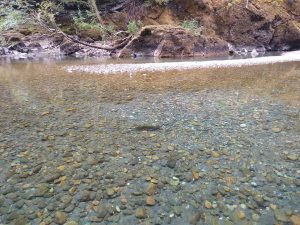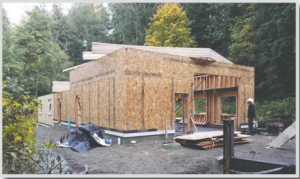The Hood Canal is defined by its picturesque views, abundance of Washington State Parks, and dense surrounding forests. Below the depths of the waters in this region lives an animal that has become a mascot for the area, the chum salmon. Millions of these fish are released from the Skokomish Indian Tribe’s Enetai Hatchery. The efforts made are what enriches the canal and the people that live here each and every year.
 “The Enetai Hatchery currently releases approximately 3,000,000 fall chum salmon into Hood Canal every year,” explains Director of the Skokomish Department of Natural Resources, Joseph Pavel. “These releases over the last 10 years have contributed 7 to 15 percent to the overall Hood Canal terminal run-size (which includes escapement and landed catch) of fall chum salmon available for tribal commercial harvesters and the Washington State All Citizens commercial and recreational fisheries.”
“The Enetai Hatchery currently releases approximately 3,000,000 fall chum salmon into Hood Canal every year,” explains Director of the Skokomish Department of Natural Resources, Joseph Pavel. “These releases over the last 10 years have contributed 7 to 15 percent to the overall Hood Canal terminal run-size (which includes escapement and landed catch) of fall chum salmon available for tribal commercial harvesters and the Washington State All Citizens commercial and recreational fisheries.”
This salmon represents the canal and the community that lives here in many ways. The Skokomish Tribe depends on this life force for a variety of reasons. “Fall chum salmon are very important for tribal ceremonial and subsistence use and are often smoked and canned,” says Pavel. “Without fish, the Skokomish Tribe cannot practice its traditional way of life.”

While the hatchery has played a pinnacle role in stocking the Hood Canal with salmon, it has been lacking in infrastructure. “The Enetai Hatchery is about 40 years old,” explains Pavel. “While we’ve made improvements…it has not changed much.” The current facility is 900 square feet. This space houses the incubation tanks, a manager’s office, storage, and all of the necessary supplies for the hatchery. “The building does not even have a bathroom and we have to rent a port-a-potty.”
This lack of space and proper facilities led to a plan by the tribe to bring in a support building to the site. Set to open in 2019, the facility includes rooms needed for the people that work there like a bunk room so an employee can stay onsite 24 hours a day and a bathroom.
Beyond what the employees need from this new building, the salmon will receive an advantage as well. “Having the new support building will allow us to separate incubation from the rest of the hatchery operations,” states Pavel. “This allows for much stricter bio-security (reduces possible infection of the eggs) and allows us either enlarge or diversify our program by adding increased production, or at the very least, decrease density in existing rearing tanks. These actions will in turn increase the survival of the eggs and fish and provide even more opportunity for the fisheries. These much needed and long overdue improvements will enhance the productivity, certainty, and stability of the program while providing a much safer, more efficient, and more productive work environment.”

The survival of these fish comes down to the support of the tribe through the work being done at the Enetai Hatchery. “Apart from grants, the Enetai Hatchery is funded entirely by the Skokomish Tribe, but everyone reaps the benefits,” explains Pavel. “We have continued our commitment to improving the hatchery and are now seen as a major provider of healthy fall chum salmon to the Hood Canal.”
With the new support building, the hatchery is on track to bring more salmon to the local waterways and create a more sustainable salmon population.
“This is vital as the Tribe continues to work diligently with state, federal, local government, NGOs, and citizens to restore, recover, manage, and protect habitat and fishery resources. It is important for the community to understand the positive impacts hatcheries have and to support their continued use. The Enetai Hatchery is the Skokomish Tribe’s way of helping to give back and support this important resource.”

















































